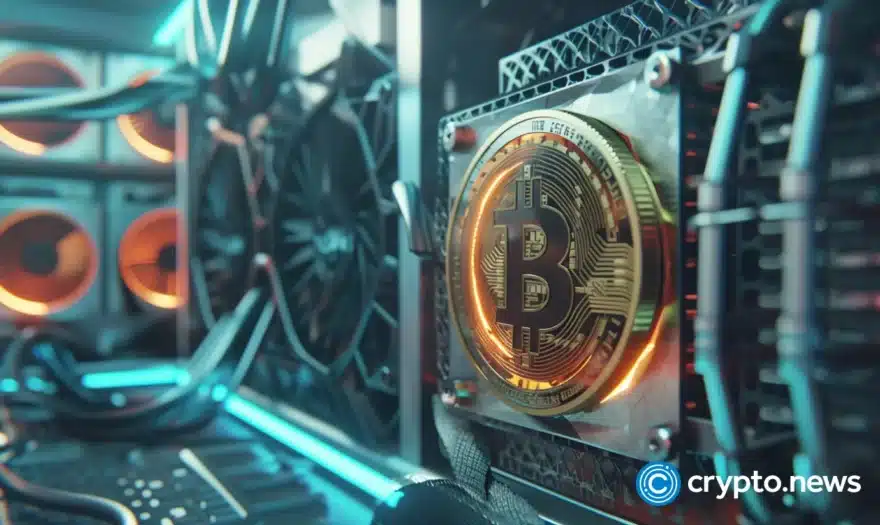What is mining difficulty? Bitcoin mining difficulty explained

While the costs of Bitcoin mining can be very high, the return on investment (ROI) is even higher for major operations with huge mining capacity.
Therefore, a solo crypto investor must understand the workings of mining before diving into this world. This guide will explore one of the most prevalent terminologies in the mining industry, Bitcoin (BTC) mining difficulty. What is it, and what are its benefits?
What is BTC mining difficulty?
BTC mining difficulty is a measure of the complexity of mining BTC. It indicates how hard it is for an average miner to verify blockchain transactions and earn a new BTC.
As mentioned above, BTC mining is a long process involving solving highly complex cryptographic equations. When the mining difficulty is great, miners use very high computing power to solve the cryptographic equations and complete transaction verification successfully; vice versa is also true.
Many experts believe the mining difficulty should be reasonably high to secure the network. Crypto blockchains with super high mining difficulty akin to BTC are highly secure.
BTC uses the mining difficulty to stabilize the average time between blocks as the network’s hash power changes.
One thing to note is that mining difficulty is a protective parameter only in proof-of-work blockchains. This is because it’s only in PoW blockchains where miners perform auditory functions preventing fraud and validating available transactions. Mining difficulty in PoW essentially controls the time taken to complete new blocks.
Why is cryptocurrency mined?
Fiat currencies rely on printing. Central Banks like the Federal Reserve or the European Central Bank can always churn out more paper.
For cryptocurrencies, there is an inherent problem. Remember the part where no central entity was supposed to control issuance? Yeah, the option of having a central institution issue crypto is not possible. Therefore, Satoshi Nakamoto created a self-sustaining system of issuing new coins.
Powerful computers help secure the network by confirming transactions, and they get new coins issued for successful blocks added to the blockchain. That process is called mining, and it is an indispensable aspect of decentralization.
What is the relevance of BTC mining difficulty?
So, why does the mining difficulty of a crypto matter? There are essentially two benefits of BTC mining difficulty, including;
- Network stability
- Network security
- Deflationary BTC value
Network Stability
One of the main pros associated with the mining difficulty is network stability. The BTC blockchain completes a new block every 10 minutes. Without the concept of mining difficulty, it would be hard to maintain stability in block release durations. Hence, mining difficulty ensures the 10-minute block creation cycle is stable.
But, why would the network autonomously increase or decrease a mining difficulty? The number of miners within the network at a particular time drives the changes in mining difficulty.
Take, for instance, a situation where many miners are concurrently fighting to mine BTC. In that case, the BTC network will increase the mining difficulty. The idea is to make it hard to mine the coins, so they maintain the stability of the 10-minute duration for releasing blocks.
When the number of miners is low, the network autonomously reduces the difficulty. This reduction will help the few miners complete blocks within ten minutes. BTC mining difficulty ensures no unpredictable overflow of new BTC in circulation.
Deflationary BTC Value in Long Term
BTC mining difficulty also helps in ensuring that the value of BTC is deflationary in the long term. As mentioned above, the difficulty removes the unpredictability of the low of new BTC in circulation. The BTC release is expected, hence does not affect the prices of the coin in exchanges.
Network Security
Network security is another benefit of the BTC mining difficulty and any adjustments involved. Blockchain networks are susceptible to attacks from bad actors, including miners. Problems like 51%-attacks are primarily a result of network miners taking advantage of the system.
BTC mining difficulty essentially increases the resources required to mine the asset. Increasing resources means increasing the costs of mining. By increasing resources, the network makes it hard for miners to attack the system since they may incur massive losses in case of failure.
How is mining difficulty changed?
As mentioned, adjustments to mining difficulty are necessary to ensure the network maintains stability. So, how does the network adjust the mining difficulty?
When mining, miners have a target hash which they all try to beat. A target hash in BTC is a specific fixed length code with several zeros before the code itself. To be considered the winning miner;
- Before the hash, you must generate a code with either an equal or more zeros.
- You must be the first to generate this code.
Hence, to ensure the blocks are not discovered superfast, BTC has algorithms that add or reduce the number of zeros preceding the target hash. Adding the zeros hardens the block discovery process while doing the opposite simplifies the block mining process. By making the mining process hard, the BTC network helps maintain the coin’s steadily growing value.
How can you calculate mining difficulty?
The calculation of BTC mining difficulty is also another vital factor to consider. How can a miner know their mining difficulty? There are many different formulas used today, but the most popular are;
Difficulty Level = Difficulty Target/Current Target.
Where;
- The difficulty target is simply the hexadecimal notation of the target hash with a mining difficulty of 1.
- Current target. Target hash of a most immediate block of transactions.
Whenever you divide the difficulty target by the current target, you get a whole number: the difficulty level. If you get your answer as 25 trillion, that is the mining difficulty, meaning you must generate over 25 trillion hashes to get the winning hash. In some cases, miners could get the correct hash with fewer guesses.
Adjustments to Mining Difficulty
As mentioned earlier, the average time for releasing a single BTC block is 10 minutes. The difficulty adjustments compare the average time required to find 2016 blocks on the network versus the time it took to get the immediate 2016 blocks. The 2016-block interval is an epoch. After every epoch, the BTC network calculates and re-adjusts the mining difficulty.
The standard time needed in mining the 2016 blocks is 20160 minutes (2016 X 10 minutes). 20160 minutes is the equivalent of a fortnight of block production. Now, the calculation for adjusting mining difficulty is as follows;
20160 minutes/actual time used in last 2016(epoch) X most recent difficulty level= Percentage upward or downward change in mining difficulty
If the percentage change is over 300%(4X) to the positive, the network will only adjust to 300%. This +300% change was done on July 16th, 2010, after the hashrate grew from 300 to 1300 MH/s in the preceding epoch.
The change can only be as low as -75%(¼) on the negative side of every epoch. The most minimal adjustment was -27.9% on July 3rd, 2021, after the Sicuan shutdowns. The limits to percentage upwards or downward changes in mining difficulty ensure there are no massive abrupt changes.
While the epoch consists of 2016 blocks, only 2015 blocks are relevant in difficulty-level computations.
What if all BTC is mined?
So, what happens with BTC mining difficulty once the BTC mining process ends? Basically, after mining all 21 million coins, the idea of mining BTC could lose meaning.
However, transaction verification and network security will remain highly relevant in the ecosystem. Hence, miners will still have to participate to ensure the BTC network continues to run. The reward, in this case, will not be new coins but transaction fees.
Final Words
This guide looked deeply into the concept of BTC mining difficulty and how you can calculate it and adjust your predictions accordingly. As severely reiterated, BTC mining’s difficulty is the complexity involved in releasing new BTCs into circulation. This process in the blockchain helps maintain the BTC network’s security and stability while also ensuring a deflationary value of BTC in the long term.
FAQs
What is Bitcoin Mining?
Bitcoin mining is a process in which computers do complex mathematical calculations to solve cryptographic puzzles and create new BTC. This process can be used to confirm transactions between two parties, verify BTC payments or create secure records.
How much time do I need to mine Bitcoin?
Mining BTC is not similar to mining other cryptocurrencies like Litecoin or Dogecoins. Each computer has a set amount of processing power which they use to solve mathematical equations for new blocks of currency to be added to the blockchain. The first person who solves the equation gets rewarded with new coins, while all participants are given some.
Mining difficulty increases every 2016 block, making it increasingly difficult to find blocks. As such, miners must upgrade their hardware regularly. If done correctly, the process should provide a reward proportional to how much effort was put into solving the problem. One BTC equals 10^9 bytes of information, and it takes about 1 min to confirm a block. This means that the average confirmation time is 10 minutes.
Is mining Bitcoin difficult?
These days, mining BTC is challenging because of heightened competition and rising processing demands. As additional miners join, the complexity of the process, which entails solving challenging mathematical problems, is adjusted to maintain a 10-minute block period.
Nowadays, most people cannot mine from home since it requires specialized ASIC equipment. The process also uses a lot of energy, and the cost of electricity has a big impact on profitability. All things considered, mining BTC is difficult and necessitates a large hardware and electrical expenditure.
Is mining Bitcoin easier than mining Ethereum?
Although mining is no longer feasible on the Ethereum mainnet, it is still feasible on Ethereum (ETH) Classic, which still employs the proof-of-work concept. ETH’s staking strategy uses a lot less energy than BTC mining, which uses a lot of power using ASIC technology. ETH staking is more accessible since it just requires 32 ETH or a staking pool, while BTC mining requires expensive equipment. While ETH staking provides consistent profits with less operational hazards, BTC mining has a tremendous earning potential but also substantial costs.
What Causes Mining Difficulty To Go Up?
The mining difficulty of a proof-of-work blockchain fluctuates, with the main driver being the number of participating miners.
However, miners are profit-oriented, expecting revenue from block rewards to offset their resource expenditure. During periods of high prices, mining difficulty is often highest as more people get involved and even those with older equipment become profitable again. Therefore, the hash rate is also impacted mainly by the coin’s price.
In a bullish market, a network’s mining difficulty will always rise as more miners connect, supplying a hash rate. In response, the network’s mining algorithm readjusts difficulty, raising it in response to increasing hash rate.















